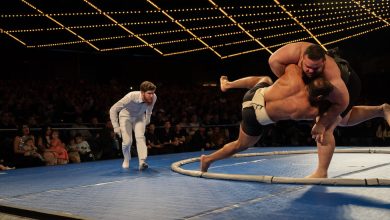Women’s Tennis Stages a Fitting Finale to a Zany Year

GUADALAJARA, Mexico — Karolina Pliskova let out a good long breath Sunday afternoon when she finally defeated Barbora Krejcikova to finish off her round-robin play at the WTA Finals Sunday afternoon.
After three sets in intense sun, there was nothing left to do but wait for the evening session’s outcome, and then, perhaps, play the final two matches of this ridiculously long and taxing year filled with restrictive bubbles and unmatched drama — and more Covid-19 tests than anyone cares to think about.
Finally, mercifully, the 11-month endurance test that has been women’s tennis this year is approaching a fitting end in this near-mile-high city in central Mexico.
Everything about these WTA Finals is so 2021. The season essentially began with more than two dozen players locked in their hotel rooms in Melbourne, Australia, for two weeks because they flew on planes with other players or coaches who tested positive for the coronavirus upon their arrival. So it was only proper that this tournament, which was supposed to be in China, faced its own pandemic-related upheaval. Tour officials had to scramble, moving the tournament out of a country that had largely prohibited foreigners from entering the country.
As the final matches of the year were unfolding, tour officials were also confronting a claim this month by the Chinese player Peng Shuai, 35, who in a social media post said she had been sexually assaulted by a top official in the Chinese government. Her post has since been taken down, and on Sunday, Steve Simon, chief executive of the WTA Tour, which does extensive business in China, called on officials there to investigate the claim fully and transparently.
The tour’s ties to China are deep though. After her match on Sunday, hours after the WTA released its statement condemning the Chinese, Pliskova was asked to film a promotional spot on behalf of the WTA in which she watched messages wishing her well from Chinese fans on an iPad, then recited a short script that culminated with, “I hope to see you soon in China.”
A spokesman for the WTA said the message was targeted to Chinese fans, not government officials.
Beyond logistical hurdles and the mounting China controversy, the most fitting tribute to this roller coaster of a season is that the eight players who earned the privilege of playing in the WTA Finals were about as random a collection as anyone could have imagined. In a sport in which seemingly any player can win a tournament, in which even a teenage qualifier this year surged to a Grand Slam event title, nothing was more appropriate than hearing player after player here confess to not being able to fathom at the start of the year that they would qualify for this exclusive championship.
Paula Badosa of Spain said that in In January in Abu Dhabi, her coach told her that if she maintained her level she would make the top 30. Badosa, a fast-improving 23-year-old, told him that was impossible, that she would settle for the top 50.
After winning the BNP Paribas Open in Indian Wells, Calif., in October, she cracked the top 10. “I didn’t even expect it,” Badosa said ahead of her first match here, a 6-4, 6-0 demolition of the Belarusian Aryna Sabalenka, the No. 1 seed. “Even less expected to be here in the WTA Finals.”
Has there been a tennis season when the beginning and the end looked so different, and not merely because empty stadiums have given way to filled arenas? In February, after the Australian Open, where Naomi Osaka of Japan won her second consecutive Grand Slam singles event and the fourth of her career, she appeared ready to take control of the sport. Ten months later, she is on indefinite leave as she deals with her mental health. No one knows when, or if, she will return.
Serena Williams made the semifinals in Australia and appeared poised for a serious try for a record-tying 24th Grand Slam singles title. She has been sidelined with injuries since the early summer. Ashleigh Barty of Australia, the 2021 Wimbledon champion, passed on the last two months of the season after an exhausting half-year on the road.
The American Sofia Kenin, who arrived in Australia as the defending champion, endured an emergency appendectomy, Covid-19 and a split with her father and coach, Alex Kenin. She tumbled out of the top 10. Simona Halep of Romania, the No. 2 seed in Australia, battled injuries and is now ranked 22nd.
The only player to make it back to this championship from 2019, the last time it was played, was Pliskova of the Czech Republic. In place of the usual stars are players like Maria Sakkari, a 26-year-old from Greece with a physique more typical of a mixed martial arts fighter than a tennis player. She cracked the top 20 only last year.
The biggest name in the game at the moment, Emma Raducanu of Britain, the qualifier who won the U.S. Open in September, is not here because she did not qualify. The qualification requirements were made when everyone just assumed that anyone good enough to win a Grand Slam event would certainly be among the top-ranked players still playing at the end of the year. In a perfect world, the tour finals would feature all the Grand Slam champions and finalists.
Alas, this championship has just a single Grand Slam singles champion from this year, Krejcikova, known until recently as a doubles specialist, who came out of nowhere to win the 2021 French Open. There is just one other Grand Slam finalist — Pliskova, who lost to Barty at Wimbledon. There, Barty looked like she might not lose again for a while, but she did not even make the second week of the U.S. Open and called it a season.
As the last preliminary-round matches opened Sunday, little known Anett Kontaveit of Estonia — no one’s current idea of a tennis star — had emerged as a worldbeater, the winner of her last two tournaments and her first two matches in Mexico. Kontaveit, 25, was the last player to qualify for Guadalajara, but the first player to make it through to the semifinals.
“I feel like I can take on anyone,” Kontaveit said Friday, after she blasted Pliskova, 6-4, 6-0, hitting the ball harder and flatter than in the past. “It’s really just trusting my shots a little more, going for it, but going for it with margins.”
Badosa, too, has continued her new tricks, fulfilling the promise that the tennis cognoscenti had predicted when she was a rising junior. She finished last year ranked 70th, and spent much of the first part of the year losing crucial points in her biggest matches. Not these days: On Saturday, she won nearly all of them, floating across the baseline as she knocked off Sakkari, 7-6 (4), 6-4.
“It’s experience,” Badosa said. “I was quite new at the beginning of the year.”
With three days to go, the WTA Finals are shaping up as a glimpse of what the next season holds for this topsy-turvy sport rather than as a crowning of a champion of champions. Given the tumult in recent years, expecting anything specific from any one player from month to month, much less season to season, has become something of a fool’s errand.
It’s better to just digest the competition as a snapshot of who is hot and who is not at a moment that just happens to be the end of the season.
Those snapshots include Kontaveit almost never missing; Badosa wearing out the paint in the corners of the court with her forehand; Sabalenka blasting 120-mile-per-hour second serves and willing the crowd into her corner in a come-from-behind, three-set win over Iga Swiatek of Poland on Saturday night.
“I kept saying, ‘You have to get through this challenge, you have to get through this challenge,’ again and again,” Sabalenka said at the end.
She was talking about the match. She could have been talking about the season.




